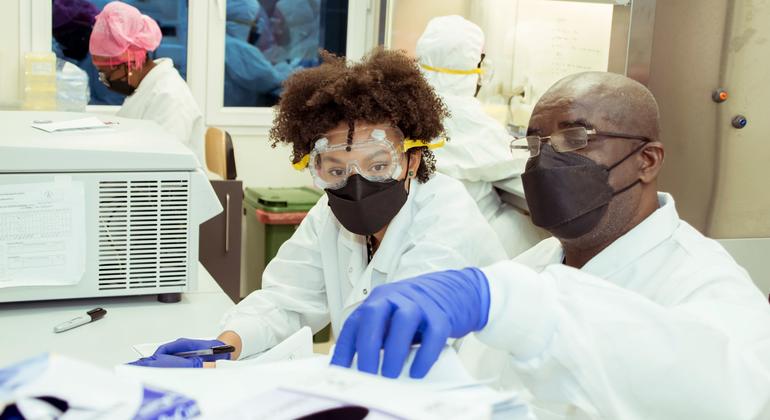Origin of the Monkeypox Outbreak Becomes Clearer to Scientists

[ad_1]
When the first monkeypox cases were identified in early May, European health officials were stumped. The virus was not known to spread easily among people, let alone infect dozens — and soon hundreds — of young men.
The origins of the outbreak are now becoming clearer. Genetic analysis suggests that although the monkeypox virus is rapidly spreading in the open, it has been silently circulating in people for years.
Health officials have already identified two versions of monkeypox among American patients, suggesting at least two separate chains of transmission. Researchers in several countries have found cases with no known source of infection, indicating undetected community spread. And one research team argued last month that monkeypox had already crossed a threshold into sustainable person-to-person transmission.
The genetic information available so far indicated that, at some point in the last few years, the virus became better at spreading between people, said Trevor Bedford, an evolutionary biologist at the Fred Hutchinson Cancer Research Center in Seattle.
“Genomic patterns would suggest this occurred around 2018,” Dr. Bedford said.
If the virus has adapted to include people as hosts, monkeypox outbreaks could become more frequent and more difficult to contain. That carries the risk that monkeypox could spill over from infected people into animals — most likely rodents — in countries outside Africa, which has struggled with that problem for decades. The virus may persist in infected animals, sporadically triggering new infections in people.
“We can also transmit this back to animals that can spread the disease within wildlife and back to humans,” said Sagan Friant, an anthropologist at Pennsylvania State University who has studied human-animal interactions in Nigeria for about 15 years.
The longer it takes to contain the virus, the higher the odds that it will find a permanent new home in people or animals, Dr. Friant said.
As of Wednesday, the United States had identified 156 cases in 23 states and the District of Columbia. The global toll has surpassed 3,400 confirmed cases, and another 3,500 cases are being evaluated, tripling the numbers from two weeks ago.
In Africa, eight countries had reported more than 1,500 suspected cases and 72 deaths as of June 10, most of which were in the Democratic Republic of Congo.
Monkeypox is a large double-stranded DNA virus, about seven times as large as the coronavirus. DNA-based viruses can correct their own errors when they replicate their genetic material. They may collect just one or two mutations per year compared with 20 to 30 mutations for an RNA virus like the coronavirus.
But the monkeypox virus seems to have amassed an unexpectedly high number of mutations — nearly 50 compared to a version that circulated in 2018, according to preliminary analyses.
Of the 47 mutations identified in one analysis, 42 carry the distinct signature of an enzyme called Apobec3. This enzyme, first discovered by researchers studying H.I.V., is a so-called host defense factor — an immune-system weapon that animals and people use to disarm viruses like monkeypox.
The enzyme essentially forces viruses to make mistakes when they try to replicate, causing them to self-destruct. Mice carry just one version of this enzyme, while humans have seven. The rapid accumulation of mutations, characteristic of the enzyme since 2018, suggests that monkeypox may have switched to people as hosts around then, Dr. Bedford said.
It is unclear how the mutations might change the virus. Of 48 mutations identified in Britain, 21 may affect how the disease spreads, its severity and how well it responds to a treatment called tecovirimat, according to the U.K. Health Security Agency.
But because mutations introduced by the enzyme Apobec3 are meant to harm the virus, their quantity alone is not worrying, said Michael Malim, a virologist at King’s College London who discovered Apobec3 in 2002. The effect of the mutations is “more likely to be debilitating,” he said. Comparing the current version of the virus with samples from the past few years might help understand how it has evolved, but that information is scarce. Nigeria did not have the ability to sequence genetic material until 2017.
Since then, scientists there have been analyzing the sequences from about 50 monkeypox cases, according to Dr. Ifedayo Adetifa, director of the Nigeria Center for Disease Control. But without the specialized equipment or expertise needed for rapid analysis, the scientists have not yet completed their work, he said.
Although the researchers have fielded several requests for the data from outside Nigeria, Dr. Adetifa said they would wait to publish their work to prevent teams with more resources from outcompeting them and grabbing credit.
What to Know About the Monkeypox Virus
What is monkeypox? Monkeypox is a virus endemic in parts of Central and West Africa. It is similar to smallpox, but less severe. It was discovered in 1958, after outbreaks occurred in monkeys kept for research, according to the Centers for Disease Control and Prevention.
“I’m all for open data sharing and all of that,” he said. “Question is, who benefits?”
Some experts have cautioned for years that the eradication of smallpox in 1980 left the world vulnerable to the broader family of poxviruses and raised the odds of monkeypox evolving into a successful human pathogen.
In West Africa, the incidence of monkeypox has increased at least twentyfold since 1986. In African countries generally, Dr. Adetifa said, “we suspect some underreporting because there’s been relatively low awareness and maybe low perceived risk of monkeypox.” Nigeria is stepping up its surveillance of monkeypox, and case numbers may rise as more people become aware of the virus, he added.
Although monkeypox has a distinctive rash that appears on the palms of the hands and soles of the feet, it is frequently confused with chickenpox. Many men in the current outbreak have lesions on their genitalia, but those can be mistaken for sexually transmitted infections such as syphilis, gonorrhea and chlamydia.
Researchers in Italy and Germany have reported finding monkeypox DNA in semen, but it is unclear if the virus spreads that way or is merely present in semen and vaginal secretions.
The spread among young men with genital ulcers was observed at least once before. In 2017, Nigeria recorded 228 suspected cases of monkeypox and confirmed 60. The virus spread primarily among young men who had genital ulcers.
Britain’s experience indicates how complicated it can be to trace contacts of a virus that may be sexually transmitted, especially in cases where infected people have had multiple anonymous partners. In an initial analysis of a subset of cases, officials said they were able to obtain names for fewer than one-third of the 78 reported sexual contacts.
Many cases in Africa have been traced back to contact with wild animals or the use of animal products for medicinal or cultural practices.
As deforestation and urbanization drive people and animals into closer quarters, more viruses may make the jump to human hosts. Monkeypox is most likely to leap to people from rodents. There are some 2,000 species of rodents worldwide, composing 40 percent of all mammalian species. The African rope squirrel is a leading candidate as the primary reservoir for monkeypox, but there are other contenders, including striped mice and dormice, giant pouched rats, rusty-nosed rats and brush-tailed porcupines.
In a 2003 outbreak in the United States, a shipment of Gambian pouched rats imported from Africa transmitted monkeypox to prairie dogs, which then infected 71 Americans. But officials did not find signs of the virus in animals in the United States once the spate of cases had ended.
There’s no guarantee that luck will hold this time. “These spillovers from other species, and what that means and what the trajectory is — it’s very unpredictable,” Dr. Malim said. “And it’s occurring more and more.”
[ad_2]




